The global single air chamber hydro-pneumatic suspension market is valued at USD 4,861.1 million in 2025 and is slated to reach USD 8,955.1 million by 2035, recording an absolute increase of USD 4,094.0 million over the forecast period. This translates into a total growth of 84.3%, with the market forecast to expand at a compound annual growth rate (CAGR) of 6.3% between 2025 and 2035. The overall market size is expected to grow by nearly 1.84X during the same period, supported by increasing demand for advanced vehicle ride comfort systems, growing adoption of intelligent suspension technologies in premium automotive segments, and rising preference for enhanced vehicle stability and handling performance across passenger and commercial vehicle applications.
Between 2025 and 2030, the single air chamber hydro-pneumatic suspension market is projected to expand from USD 4,861.1 million to USD 6,597.9 million, resulting in a value increase of USD 1,736.8 million, which represents 42.4% of the total forecast growth for the decade. This phase of development will be shaped by increasing adoption of active suspension control technologies, rising demand for enhanced vehicle comfort systems, and growing emphasis on adaptive damping capabilities with improved ride quality characteristics. Automotive manufacturers are expanding their suspension system integration to address the growing demand for premium vehicle performance, handling optimization, and advanced ride comfort requirements.
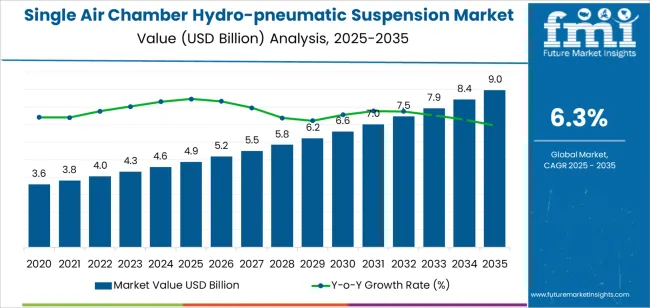
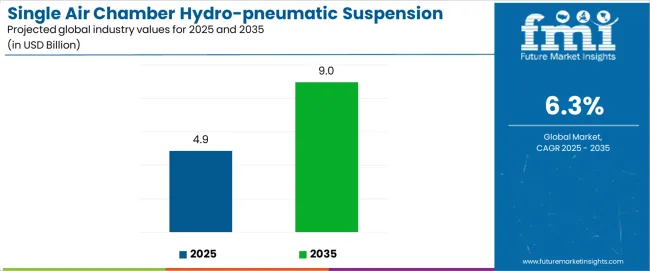
Single Air Chamber Hydro-pneumatic Suspension Market Key Takeaways
| Metric | Value |
|---|---|
| Estimated Value in (2025E) | USD 4,861.1 million |
| Forecast Value in (2035F) | USD 8,955.1 million |
| Forecast CAGR (2025 to 2035) | 6.3% |
From 2030 to 2035, the market is forecast to grow from USD 6,597.9 million to USD 8,955.1 million, adding another USD 2,357.2 million, which constitutes 57.6% of the overall ten-year expansion. This period is expected to be characterized by the expansion of intelligent suspension management systems, the integration of sensor-based adaptive technologies, and the development of multi-functional suspension platforms with enhanced performance capabilities. The growing adoption of autonomous vehicle technologies will drive demand for single air chamber hydro-pneumatic suspension systems with superior response times and compatibility with vehicle dynamics control systems across automotive applications.
Between 2020 and 2025, the single air chamber hydro-pneumatic suspension market experienced robust growth, driven by increasing demand for premium automotive comfort features and growing recognition of advanced suspension technology as essential components for superior vehicle performance across luxury passenger vehicles, commercial transportation, and specialized vehicle applications. The market developed as automotive manufacturers recognized the potential for hydro-pneumatic systems to enhance ride quality while maintaining vehicle stability and enabling cost-effective comfort solutions. Technological advancement in electronic control systems and precision hydraulic mechanisms began emphasizing the critical importance of maintaining response accuracy and performance consistency in diverse driving environments.
Market expansion is being supported by the increasing global demand for advanced automotive comfort solutions and the corresponding need for intelligent suspension systems that can provide superior ride quality and handling performance while enabling enhanced vehicle stability and reduced vibration impact across various passenger and commercial vehicle applications. Modern automotive manufacturers and vehicle comfort specialists are increasingly focused on implementing suspension technologies that can deliver adaptive responses, prevent ride harshness, and provide consistent performance throughout complex driving conditions and diverse load requirements. Single air chamber hydro-pneumatic suspension systems' proven ability to deliver exceptional comfort against road irregularities, enable responsive handling characteristics, and support cost-effective performance protocols make them essential components for contemporary automotive and transportation operations.
The growing emphasis on vehicle comfort optimization and performance enhancement is driving demand for hydro-pneumatic suspension systems that can support premium automotive requirements, improve ride quality outcomes, and enable intelligent adaptive systems. Automotive manufacturers' preference for technology that combines effective vibration control with operational responsiveness and system reliability is creating opportunities for innovative suspension implementations. The rising influence of autonomous vehicle development and advanced driver assistance systems is also contributing to increased demand for hydro-pneumatic suspension systems that can provide sensor-integrated responses, real-time adjustment capabilities, and reliable performance across extended operational periods.
The single air chamber hydro-pneumatic suspension market is poised for rapid growth and transformation. As industries across automotive, transportation, construction equipment, and specialty vehicles seek solutions that deliver exceptional ride comfort, handling precision, and operational reliability, hydro-pneumatic suspension systems are gaining prominence not just as specialized components but as strategic enablers of modern vehicle performance and comfort enhancement.
Rising premium vehicle adoption in emerging markets and expanding intelligent vehicle technologies globally amplify demand, while manufacturers are leveraging innovations in electronic control systems, adaptive damping technologies, and integrated sensor functionalities.
Pathways like intelligent adaptive systems, commercial vehicle integration, and specialized application solutions promise strong margin uplift, especially in premium automotive segments. Geographic expansion and technology integration will capture volume, particularly where local automotive manufacturing and vehicle comfort standards are critical. Regulatory support around vehicle safety requirements, comfort enhancement standards, and automotive performance regulations give structural support.
The market is segmented by chamber configuration, application, technology type, vehicle type, end-use sector, and region. By chamber configuration, the market is divided into partitioned and non-partitioned categories. By application, it covers passenger vehicles, commercial vehicles, and special vehicles. By technology type, the market includes electronic control systems, hydraulic management platforms, and mechanical control systems. By vehicle type, it is categorized into luxury vehicles, premium vehicles, standard vehicles, and commercial fleets. By end-use sector, it covers automotive manufacturers, aftermarket services, specialty vehicle producers, and transportation companies. Regionally, the market is divided into North America, Europe, East Asia, South Asia & Pacific, Latin America, and the Middle East & Africa.
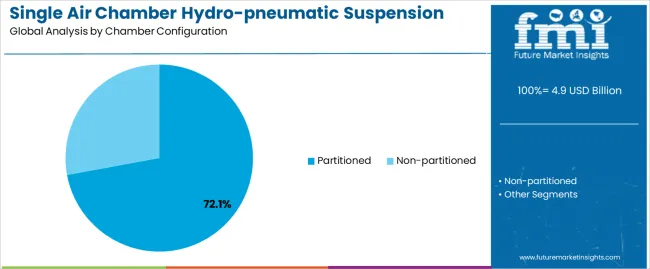
The partitioned chamber configuration segment is projected to account for 72.1% of the single air chamber hydro-pneumatic suspension market in 2025, reaffirming its position as the leading configuration category. Premium automotive manufacturers and luxury vehicle producers increasingly utilize partitioned hydro-pneumatic suspension systems for their superior performance isolation capabilities when operating across diverse driving conditions, excellent pressure management characteristics, and effectiveness in applications ranging from ride comfort enhancement to advanced handling optimization. Partitioned chamber technology's advanced pressure control capabilities and responsive adjustment mechanisms directly address the automotive requirements for comprehensive performance management in premium vehicle environments.
This configuration segment forms the foundation of modern luxury automotive applications, as it represents the suspension type with the greatest performance precision and established market demand across multiple vehicle categories and automotive sectors. Manufacturer investments in advanced electronic control systems and intelligent pressure management continue to strengthen adoption among premium automotive producers and luxury vehicle manufacturers. With companies prioritizing ride quality optimization and handling excellence, partitioned hydro-pneumatic suspension systems align with both performance requirements and comfort enhancement objectives, making them the central component of comprehensive premium vehicle strategies.
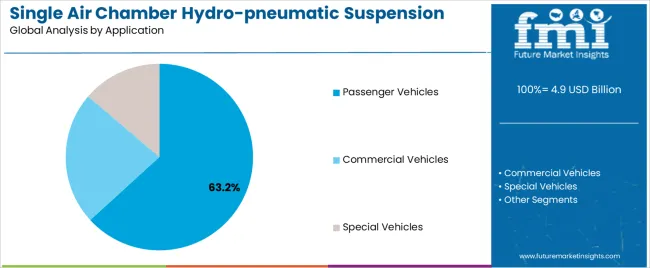
Passenger vehicle applications are projected to represent 63.2% of single air chamber hydro-pneumatic suspension demand in 2025, underscoring their critical role as the primary automotive consumers of advanced suspension technology for comfort enhancement, handling improvement, and ride quality optimization applications. Automotive manufacturers prefer hydro-pneumatic suspension systems for their exceptional comfort delivery capabilities, responsive handling characteristics, and ability to enhance vehicle stability while ensuring effective vibration control throughout diverse driving performance programs. Positioned as essential components for premium automotive applications, hydro-pneumatic suspension systems offer both comfort advantages and performance enhancement benefits.
The segment is supported by continuous innovation in electronic control technologies and the growing availability of specialized adaptive systems that enable variable response characteristics with enhanced comfort delivery and rapid adjustment capabilities. Additionally, automotive manufacturers are investing in integrated suspension management systems to support premium vehicle development and performance optimization. As luxury vehicle demand becomes more prevalent and automotive comfort requirements increase, passenger vehicle applications will continue to dominate the end-use market while supporting advanced automotive comfort utilization and ride quality enhancement strategies.
The single air chamber hydro-pneumatic suspension market is advancing rapidly due to increasing demand for premium automotive comfort technologies and growing adoption of intelligent suspension control solutions that provide superior ride quality and handling performance while enabling enhanced vehicle stability across diverse automotive and transportation applications. However, the market faces challenges, including high system complexity costs, maintenance requirement considerations, and the need for specialized technical expertise and service infrastructure development. Innovation in electronic control capabilities and sensor-integrated adaptive systems continues to influence product development and market expansion patterns.
Expansion of Electronic Control and Sensor Integration Technologies
The growing adoption of electronic suspension management systems, sensor-based adaptive algorithms, and intelligent response optimization is enabling manufacturers to produce advanced hydro-pneumatic suspension systems with superior adjustment capabilities, enhanced performance precision, and automated comfort delivery functionalities. Advanced electronic control systems provide improved ride quality while allowing more efficient response management and consistent performance across various driving conditions and load variations. Manufacturers are increasingly recognizing the competitive advantages of intelligent suspension capabilities for performance differentiation and premium market positioning.
Integration of Vehicle Dynamics and Advanced Driver Assistance
Modern hydro-pneumatic suspension producers are incorporating vehicle dynamics integration, advanced driver assistance compatibility, and comprehensive vehicle performance systems to enhance operational intelligence, enable predictive adjustment capabilities, and deliver value-added solutions to automotive customers. These technologies improve vehicle performance while enabling new comfort capabilities, including real-time road condition adaptation, handling optimization tracking, and reduced operational complexity. Advanced system integration also allows manufacturers to support comprehensive vehicle dynamics management and automotive modernization beyond traditional passive suspension approaches.
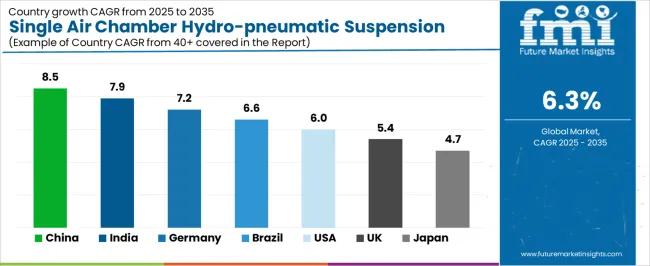
| Country | CAGR (2025 to 2035) |
|---|---|
| China | 8.5% |
| India | 7.9% |
| Germany | 7.2% |
| Brazil | 6.6% |
| USA | 6.0% |
| UK | 5.4% |
| Japan | 4.7% |
The single air chamber hydro-pneumatic suspension market is experiencing strong growth globally, with China leading at an 8.5% CAGR through 2035, driven by the expanding automotive manufacturing sector, growing premium vehicle adoption, and significant investment in advanced suspension technology development. India follows at 7.9%, supported by government initiatives promoting automotive technology, increasing vehicle comfort demand, and growing luxury vehicle requirements. Germany shows growth at 7.2%, emphasizing premium automotive innovation and advanced vehicle technology development. Brazil records 6.6%, focusing on automotive sector expansion and commercial vehicle modernization. The USA demonstrates 6.0% growth, prioritizing automotive comfort standards and vehicle performance excellence. The UK exhibits 5.4% growth, emphasizing automotive technology adoption and premium vehicle development. Japan shows 4.7% growth, supported by advanced automotive technology initiatives and precision vehicle manufacturing concentration.
The report covers an in-depth analysis of 40+ countries top-performing countries are highlighted below.
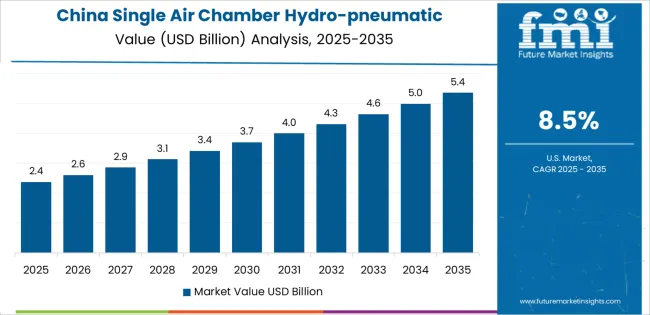
Revenue from single air chamber hydro-pneumatic suspension systems in China is projected to exhibit exceptional growth with a CAGR of 8.5% through 2035, driven by expanding automotive manufacturing capabilities and rapidly growing premium vehicle adoption supported by government initiatives promoting automotive technology advancement. The country's strong position in automotive production and increasing investment in vehicle comfort infrastructure are creating substantial demand for advanced hydro-pneumatic suspension solutions. Major automotive manufacturers and vehicle producers are establishing comprehensive suspension integration capabilities to serve both domestic premium vehicle demand and automotive export markets.
Revenue from single air chamber hydro-pneumatic suspension systems in India is expanding at a CAGR of 7.9%, supported by the country's growing automotive sector, expanding government support for vehicle modernization, and increasing adoption of premium automotive technologies. The country's initiatives promoting automotive advancement and growing consumer awareness are driving requirements for advanced vehicle comfort capabilities. International suppliers and domestic manufacturers are establishing extensive production and service capabilities to address the growing demand for hydro-pneumatic suspension products.
Revenue from single air chamber hydro-pneumatic suspension systems in Germany is expanding at a CAGR of 7.2%, supported by the country's advanced premium automotive capabilities, strong emphasis on vehicle technology innovation, and robust demand for high-performance automotive components in luxury vehicle and automotive engineering applications. The nation's mature automotive sector and performance-focused operations are driving sophisticated hydro-pneumatic suspension systems throughout the automotive industry. Leading manufacturers and technology providers are investing extensively in intelligent control systems and precision suspension technologies to serve both domestic and international markets.
Revenue from single air chamber hydro-pneumatic suspension systems in Brazil is growing at a CAGR of 6.6%, driven by the country's expanding automotive sector, growing commercial vehicle operations, and increasing investment in automotive technology development. Brazil's automotive manufacturing expansion and commitment to vehicle modernization are supporting demand for efficient hydro-pneumatic suspension solutions across multiple vehicle production segments. Manufacturers are establishing comprehensive service capabilities to serve the growing domestic market and automotive development opportunities.
Revenue from single air chamber hydro-pneumatic suspension systems in the USA is expanding at a CAGR of 6.0%, supported by the country's advanced automotive technology sector, strategic focus on vehicle performance, and established premium automotive capabilities. The USA's automotive innovation leadership and technology integration are driving demand for hydro-pneumatic suspension systems in luxury vehicle manufacturing, specialty automotive production, and advanced vehicle applications. Manufacturers are investing in comprehensive technology development to serve both domestic automotive markets and international premium applications.
Revenue from single air chamber hydro-pneumatic suspension systems in the UK is growing at a CAGR of 5.4%, driven by the country's focus on automotive technology advancement, emphasis on vehicle performance, and strong position in premium automotive development. The UK's established automotive innovation capabilities and commitment to vehicle modernization are supporting investment in advanced suspension technologies throughout major automotive regions. Industry leaders are establishing comprehensive technology integration systems to serve domestic automotive operations and specialty vehicle applications.
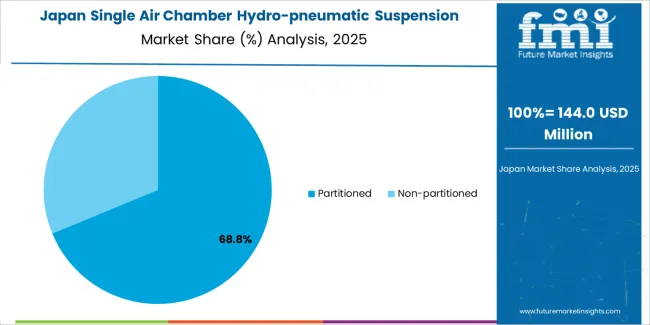
Revenue from single air chamber hydro-pneumatic suspension systems in Japan is expanding at a CAGR of 4.7%, supported by the country's advanced automotive technology initiatives, growing precision vehicle sector, and strategic emphasis on automotive component development. Japan's established technology capabilities and integrated automotive systems are driving demand for advanced hydro-pneumatic suspension systems in luxury vehicle production, precision automotive applications, and high-performance vehicle systems. Leading manufacturers are investing in specialized capabilities to serve the stringent requirements of advanced automotive technology and precision vehicle industries.
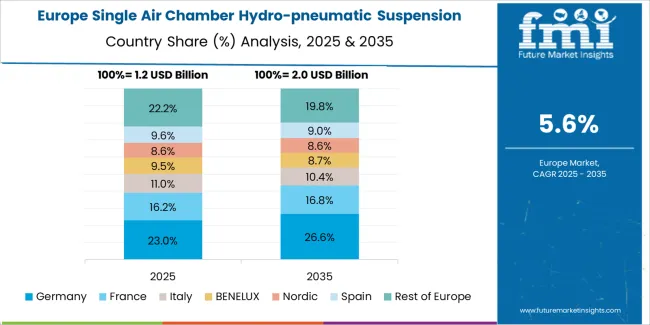
The single air chamber hydro-pneumatic suspension market in Europe is projected to grow from USD 873.2 million in 2025 to USD 1,612.8 million by 2035, registering a CAGR of 6.3% over the forecast period. Germany is expected to maintain its leadership position with a 42.8% market share in 2025, declining slightly to 42.1% by 2035, supported by its strong premium automotive sector, advanced vehicle technology capabilities, and comprehensive automotive component industry serving diverse hydro-pneumatic suspension applications across Europe.
France follows with a 21.3% share in 2025, projected to reach 21.8% by 2035, driven by robust demand for suspension systems in luxury automotive production, vehicle modernization programs, and premium automotive applications, combined with established automotive technology infrastructure and specialty vehicle expertise. The United Kingdom holds a 14.7% share in 2025, expected to reach 15.2% by 2035, supported by strong automotive technology sector and growing premium vehicle activities. Italy commands a 10.8% share in 2025, projected to reach 11.1% by 2035, while Spain accounts for 6.5% in 2025, expected to reach 6.8% by 2035. The Netherlands maintains a 2.4% share in 2025, growing to 2.5% by 2035. The Rest of Europe region, including Nordic countries, Eastern Europe, Belgium, Poland, and other nations, is anticipated to maintain momentum, with its collective share moving from 1.5% to 0.5% by 2035, attributed to increasing automotive modernization in Eastern Europe and growing premium vehicle penetration in Nordic countries implementing advanced automotive technology programs.
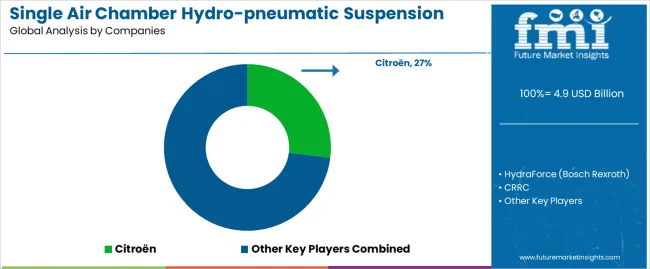
The single air chamber hydro-pneumatic suspension market is characterized by competition among established automotive component manufacturers, specialized suspension technology producers, and integrated vehicle system solutions providers. Companies are investing in electronic control system research, pressure management optimization, adaptive suspension development, and comprehensive product portfolios to deliver consistent, high-performance, and application-specific hydro-pneumatic suspension solutions. Innovation in intelligent control systems, sensor integration, and performance enhancement is central to strengthening market position and competitive advantage.
Citroën leads the market with a strong market share, offering comprehensive hydro-pneumatic suspension solutions including advanced control systems with a focus on automotive and premium vehicle applications. HydraForce (Bosch Rexroth) provides specialized hydraulic control capabilities with an emphasis on precision pressure management and automated vehicle performance systems. CRRC delivers innovative transportation solutions with a focus on commercial vehicle platforms and specialized transportation services. HYDAC specializes in hydraulic system automation and suspension technologies for automotive applications. Shandong Wantong Hydraulic focuses on precision hydraulic equipment and integrated automotive solutions. HYPSUS offers specialized suspension platforms with emphasis on premium automotive and performance vehicle applications.
Key Players in the Single Air Chamber Hydro-pneumatic Suspension Market
| Items | Values |
|---|---|
| Quantitative Units (2025) | USD 4,861.1 million |
| Chamber Configuration | Partitioned, Non-partitioned |
| Application | Passenger Vehicles, Commercial Vehicles, Special Vehicles |
| Technology Type | Electronic Control Systems, Hydraulic Management Platforms, Mechanical Control Systems |
| Vehicle Type | Luxury Vehicles, Premium Vehicles, Standard Vehicles, Commercial Fleets |
| End-Use Sector | Automotive Manufacturers, Aftermarket Services, Specialty Vehicle Producers, Transportation Companies |
| Regions Covered | North America, Europe, East Asia, South Asia & Pacific, Latin America, Middle East & Africa |
| Countries Covered | China, India, Germany, Brazil, United States, United Kingdom, Japan and 40+ countries |
| Key Companies Profiled | Citroën, HydraForce (Bosch Rexroth), CRRC, HYDAC, Shandong Wantong Hydraulic, and HYPSUS |
| Additional Attributes | Dollar sales by chamber configuration and application category, regional demand trends, competitive landscape, technological advancements in electronic control systems, adaptive suspension development, sensor integration innovation, and automotive system integration |
The global single air chamber hydro-pneumatic suspension market is estimated to be valued at USD 4.9 billion in 2025.
The market size for the single air chamber hydro-pneumatic suspension market is projected to reach USD 9.0 billion by 2035.
The single air chamber hydro-pneumatic suspension market is expected to grow at a 6.3% CAGR between 2025 and 2035.
The key product types in single air chamber hydro-pneumatic suspension market are partitioned and non-partitioned.
In terms of application, passenger vehicles segment to command 63.2% share in the single air chamber hydro-pneumatic suspension market in 2025.






Full Research Suite comprises of:
Market outlook & trends analysis
Interviews & case studies
Strategic recommendations
Vendor profiles & capabilities analysis
5-year forecasts
8 regions and 60+ country-level data splits
Market segment data splits
12 months of continuous data updates
DELIVERED AS:
PDF EXCEL ONLINE
Single-channel Frequency Synthesizer Market Size and Share Forecast Outlook 2025 to 2035
Single-axis Drives Market Size and Share Forecast Outlook 2025 to 2035
Single Roller Cone Bits Market Size and Share Forecast Outlook 2025 to 2035
Single Phase Spot Welder Machine Market Size and Share Forecast Outlook 2025 to 2035
Single Phase Spot Welder Market Size and Share Forecast Outlook 2025 to 2035
Single-use Bioreactors Market Size and Share Forecast Outlook 2025 to 2035
Single Board Computer Market Size and Share Forecast Outlook 2025 to 2035
Single-Serve Packaging Market Size and Share Forecast Outlook 2025 to 2035
Single Phase Recloser Market Size and Share Forecast Outlook 2025 to 2035
Single Phase Portable Conventional Gensets Market Size and Share Forecast Outlook 2025 to 2035
Single Phase Residential Voltage Regulator Market Size and Share Forecast Outlook 2025 to 2035
Single Phase Shunt Reactor Market Size and Share Forecast Outlook 2025 to 2035
Single Screw Extruder Market Size and Share Forecast Outlook 2025 to 2035
Single Phase Residential Power Conditioner Market Size and Share Forecast Outlook 2025 to 2035
Single Phase PV Inverter Market Size and Share Forecast Outlook 2025 to 2035
Single Phase Portable Generators Market Size and Share Forecast Outlook 2025 to 2035
Single Core Armored Cable Market Size and Share Forecast Outlook 2025 to 2035
Single Axis Solar Tracker Market Size and Share Forecast Outlook 2025 to 2035
Single Phase Commercial Voltage Regulator Market Size and Share Forecast Outlook 2025 to 2035
Single Phase Home Standby Gensets Market Size and Share Forecast Outlook 2025 to 2035

Thank you!
You will receive an email from our Business Development Manager. Please be sure to check your SPAM/JUNK folder too.
Chat With
MaRIA